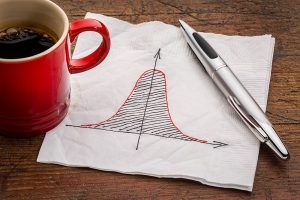How Gold Performs in “Left Tail” Events
Posted onAn event that has a small probability of occurring is sometimes called a tail event. The “tail” is the sloping far left and right sides of a normal distribution curve. These are the areas that sit outside the main bulge of the curve. 
If the tail represents uncommon outcomes, why do they matter?
They matter because when they do happen, they often present dramatic outcomes.
In his 2007 best-seller, The Black Swan: The Impact of the Highly Improbable, author Nassim Taleb explored the concept of tail risk. The message of the book is clear: we are often blind to randomness and this blindness leaves us unknowingly exposed to risks that can have devastating consequences. While these risks are unlikely, people need to be prepared for them. If they ignore them, they are choosing to ignore events that could have permanent consequences.
The “tail” however, is not always something to fear. When considered in the context of a diversified portfolio, the tail represents both threats and opportunities. Consider that “gold tends to outperform in left-tail events,” according to research recently published by the World Gold Council.
This out-performance does not necessarily look like skyrocketing returns. Sometimes, an outperforming asset is one that maintains its value in a setting in which most other assets plummet. This characteristic of gold is important because, as Taleb argues, the world we live in is becoming increasingly fragile. This is a result of increasingly interconnected financial systems in which each individual part can have a massive impact on the whole
Others have explored this idea. In his book Normal Accidents, author Charles Perrow warns that “we create systems—organizations, and the organization of organizations—that increase the risks for the operators, passengers, innocent bystanders, and for future generations.”
Taleb summarizes that “the great danger has always been too much connectivity.” Herein lies the power gold has to add stability to a portfolio. Research from the World Gold Council finds that the correlation between gold and the stock market becomes more negative as equity market moves intensify. In other words, as the S&P 500 experiences larger swings, gold increasingly moves in an opposite direction.
Today, we can see the impact of our interconnected world. The pandemic put more cash in peoples’ hands, due to both sheltering in place and government stimulus. This led to more spending, which led to inflation. As a result, the government has been raising rates to cool the economy. This, in turn, has boosted gold prices, as seen by a 12% on a year-over-year increase in demand for the metal in the first half of 2022.
This chain of events shows both the connectedness of our financial systems and the way in which gold acts as a stabilizing force. This stability will be increasingly important as we enter a new setting in which inflation remains stubborn and as the era of cheap money comes to an end.
Want to read more? Subscribe to the Blanchard Newsletter and get our tales from the vault, our favorite stories from around the world and the latest tangible assets news delivered to your inbox weekly.







